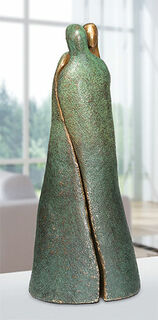3-piece sculpture "Family", bronze
3-piece sculpture "Family", bronze
Quick info
limited, 99 copies | numbered | signed | bronze | chased | patinated | height 22 + 10 cm | weight 3,9 kg
Detailed description
3-piece sculpture "Family", bronze
In Plato's Symposium, the comic poet Aristophanes explains love as follows: Humans were originally created with four arms, four legs and a head with two faces. Fearing their power, Zeus split them into two separate parts, condemning them to spend their lives in search of their other halves.
Bodirsky interprets the "spherical man" as two upright human figures that, only when joined together, form one whole. Inside them, however, the deeper meaning of their community - the child - is sheltered and protected.
3-pcs bronze sculpture, cast using the Lost-Wax-Process, chiselled and patinated by hand. Limited to 99 numbered and signed copies. Height 22 cm (couple), height 10 cm (child). Weight 3,9 kg.
Customer reviews
Bestens, gern wieder

About Maria-Luise Bodirsky
Born in 1952, sculptor and ceramist
It is the basic elements of earth, water, fire and air that the sculptor and ceramist Maria-Luise Bodirsky, born in 1952, combines in her sculptures and the working process. Clay is her elementary artistic medium when capturing, tracing and depicting the inner and outer conditions of her figures.
Bodirsky draws inspiration for her archaic-looking figures from the early human history such as ancient Egyptian culture, Greek mythology and the Old Testament, or modern literature for example of Pablo Neruda.
An alloy of copper with other metals (especially with tin) used since ancient times.
When casting bronze, the artist usually applies the lost-wax technique which is dating back more than 5000 years. It's the best, but also the most complex method of producing sculptures.
First, the artist forms a model of his sculpture. It is embedded in a liquid silicone rubber mass. Once the material has solidified, the model is cut out. The liquid wax is poured into the negative mould. After cooling down, the wax cast is removed from the mould, provided with sprues and dipped into ceramic mass. The ceramic mass is hardened in a kiln, whereby the wax flows out (lost mould).
Now we finally have the negative form, into which the 1400° C hot molten bronze is poured. After the bronze had cooled down, the ceramic shell is broken off and the sculpture is revealed.
Now the sprues are removed, the surfaces are polished, patinated and numbered by the artist himself or, to his specifications, by a specialist. Thus, each casting becomes an original work.
For lower-quality bronze castings, the sand casting method is often used which, however, does not achieve the results of a more complex lost-wax technique in terms of surface characteristics and quality.
Term for an art object (sculpture, installation), which is produced in multiple copies in a limited and numbered edition according to the artist‘s will.
Artist's multiples have been called the most accessible and affordable art on the market.
A plastic work of sculptural art made of wood, stone, ivory, bronze or other metals.
While sculptures from wood, ivory or stone are made directly from the block of material, in bronze casting a working model is prepared at first. Usually, it is made of clay or other easily mouldable materials.
The prime time of sculpture after the Greek and Roman antiquity was the Renaissance. Impressionism gave a new impulse to the sculptural arts. Contemporary artists such as Jorg Immendorf, Andora, and Markus Lupertz also enriched sculptures with outstanding works.












